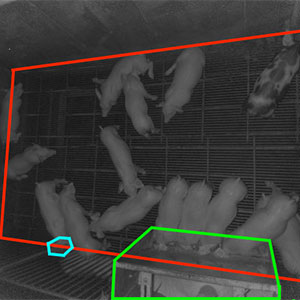Calendar Icon
Apr 10, 2017
Person Bust Icon
By Karl Vogel
![]() RSS
Submit a Story
RSS
Submit a Story

RELATED LINKS
A senior design capstone team of Nebraska computer engineering and computer science students is using 3D camera technology to allow farmers and producers to monitor the health of pigs in livestock pens and intervene before a problem becomes too advanced.
The application, called SWINDR, is one part of a larger animal health tracking project that is being overseen by the College of Engineering's Perceptual Systems Research Group (psrg.unl.edu).
The team, which was brought together through the Jeffrey S. Raikes School of Computer Science and Management, is comprised of one computer engineer, Levi Hassel, and three computer science majors – Keith Jett, Alec Skinner and Justin Collier.
The team is using a Kinect camera and small sensors on the ears of each pig to capture their activity or lack thereof within a pen.
"If a pig is starting to get sick, maybe it's sleeping a lot more or it's not eating as much," said Hassel. "On its own, that information doesn't seem very useful, but when you use machine learning, it's going to determine what makes a pig healthy or unhealthy. That's something we don't even know right now.
"For now it's about getting as much information as possible for the farmers who understand these things much better than we do."
Eric Psota, research assistant professor of electrical and computer engineering and the group's faculty adviser from PSRG, said designing this application provided a unique challenge for the team – designing a product for use by people who are not the most tech-savvy but are becoming more technology dependent.
"We take this idea that our agriculture is moving to a more automated form," Psota said. "They want something that's going to present the data to them in a meaningful way. They don't want to have to dig into the numbers. They don't even want to have to look at this thing unless there's some sort of notification."
Psota said the project boils down to students learning to get out of their comfort zone and find creative solutions. That experience could give these students a leg up in starting their post-graduation careers.
"The students can handle the data, they're used to dealing with data. But in this project, you have to think of it from a farmhand's perspective, from a user's perspective. It's something they're going to have to deal with after graduation," Psota said. "It is certainly an advantage for them to say, 'We've designed for a client. We've had to deal with many issues.' "
Taking a multidisciplinary approach to this project was something the individual team members said has opened up their horizons.
"It's been great to work with people who don't always see things exactly the same way you do," Jett said.
Looking back to the start of the project, Skinner said it was surprising to realize how much the team has done and learned. And, he said, the team is excited to see the project come together in the coming months.
"At the start, none of us had any experience with any of these technologies," Skinner said, "From the very start, the client had a broad idea of what they wanted and we did all this research and wire framing. It's really cool to see it go from a simple idea to being implemented. We can't wait to see what they're going to do with it and how it's all going to work."
Submit a Story



